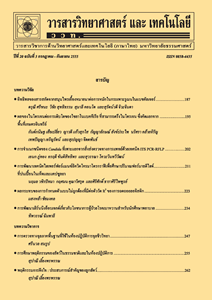ศักยภาพในการดูดซับและสะสมโลหะหนักของพืชล้มลุกชนิดเด่นบริเวณพื้นที่รอบเหมืองแร่ทองคำ จังหวัดพิจิตร
Main Article Content
Abstract
บทคัดย่อ
การปนเปื้อนของโลหะหนักในดินเป็นปัญหาสิ่งแวดล้อมที่มักพบได้จากการทำเหมืองแร่ พืชหลายชนิดที่เจริญเติบโตในพื้นที่ปนเปื้อนจึงใช้กลไกทางสรีรวิทยาในการปรับตัวเพื่อความอยู่รอด งานวิจัยนี้มีวัตถุประสงค์เพื่อศึกษาศักยภาพในการดูดซับและสะสมโลหะหนักของพืชล้มลุกในพื้นที่รอบเหมืองแร่ทองคำ อำเภอทับคล้อ จังหวัดพิจิตร โดยเก็บตัวอย่างพืชและดินมาวิเคราะห์ปริมาณแมงกานีส สารหนู ตะกั่ว สังกะสี และแคดเมียมด้วยเทคนิค ICP-OES ผลการวิเคราะห์ดินพบปริมาณสารหนูสูงเกินค่ามาตรฐาน 1.5-17 เท่า โลหะหนักชนิดอื่นมีค่าต่ำหรือสูงกว่ามาตรฐานเล็กน้อย ผลการวิเคราะห์พืช 14 ชนิด สามารถจำแนกพืชตามประเภทของการดูดซับโลหะหนักได้ดังนี้ metal hyperaccumulator ต่อสังกะสี 2 ชนิด คือ หญ้าตีนตุ๊กแก และสะเดาดิน metal excluder ต่อสังกะสี 1 ชนิด คือ ย่านาง metal excluder ต่อแมงกานีส 3 ชนิด คือ หญ้ายาง แมงลักคา และต้อยติ่ง metal indicator ต่อแมงกานีส 2 ชนิด คือ หญ้างวงช้าง และหญ้าตีนตุ๊กแก สารหนูเป็นธาตุที่มีการปนเปื้อนในดินมากที่สุด แต่ไม่พบพืชที่มีแนวโน้มจะนำมาใช้บำบัดสารหนูออกจากดินได้ อย่างไรก็ตาม ผลการวิจัยนี้จะเป็นแนวทางสำหรับการศึกษาวิจัยถึงศักยภาพของพืชในการดูดซับและสะสมธาตุโลหะหนัก เพื่อนำความรู้มาประยุกต์ให้เกิดประโยชน์ทางด้านการบำบัดดินที่ปนเปื้อนโดยใช้พืชต่อไปในอนาคต
คำสำคัญ : การสะสมโลหะหนัก; พืชล้มลุก; เหมืองแร่ทองคำ
Abstract
Heavy metals and metalloids contamination in soil is one of the serious environmental problems usually found in mining areas. Plant species growing on these contaminated soils have to adapt themselves physiologically to survive. This research aims to search for the potential of heavy metal uptake and accumulation in dominant herbaceous plants growing naturally around gold mine areas of Tab Khlo district, Pichit province. Plants and soils were collected and subjected to metal analysis using ICP-OES technique. The results showed that arsenic in soils exceeded the standard level 1.5-17 times. However, the concentrations of other metals were lower or slightly higher than the restricted values. Fourteen dominant herbaceous plant species were sampled. Coldenia procambens and Glinus oppositifolius were classified as Zinc hyperaccumulator and Tiliacora triandra was classified as zinc excluder. Manganese excluders consisted of Euphorbia heterophylla, Hyptis suaveolens and Ruellia tuberosa while Heliotropium indicum and Coldenia procambens were recognized as manganese indicators. Arsenic was the most problematic metal contamination in this area but none of the collected plants was qualified for arsenic phytoremediation. Nevertheless, results obtained from this study can be used as a guideline for research or applications related to phytoremediation in near future.
Keywords: metal accumulation; herbaceous plants; gold mine


